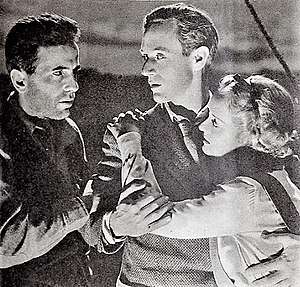Arthur Hopkins
Arthur Hopkins (October 4, 1878 – March 22, 1950) was a well-know Broadway theater director and producer in the early twentieth century. Between 1912 and 1948, he produced and staged more than 80 plays – an average of more than two per year – occasionally writing and directing as well.
Biography
Hopkins was born on October 4, 1878 in Cleveland. He was the youngest of ten children born to a Welsh couple, David and Mary Jane Hopkins. His autobiography is titled To a Lonely Boy.[1] His repertoire included plays by playwrights in American Expressionist theater, including Elmer Rice, Sophie Treadwell, and Eugene O'Neill.[2]
After leaving high school, he began life as a reporter and then worked for a while as a theater press agent. This led to his writing a play, The Fatted Calf (1912) and to producing a show, Poor Little Rich Girl, in 1913; it was a hit and launched his Broadway career. Arthur Hopkins married Australian actress Eva MacDonald in August 1915. At the time she declared that she had retired from the stage, but in 1919 she appeared as Natasha in Night Lodging, produced by Hopkins.[3]
He was one of Broadway's most admired producers with credits for What Price Glory, Anna Christie, and others. He also co-wrote Burlesque (1927), which he staged again twenty years later, and it ran from Christmas 1946 to January 1948. He directed Philip Barry's 1928 play Holiday at the Plymouth Theatre, where it ran for 229 performances. His last production – The Magnificent Yankee, based on the life of the Supreme Court Justice Oliver Wendell Holmes, Jr, in 1946 – was another hit.

Hopkins arguably was one of two key people who helped make Humphrey Bogart a star. In 1934, Hopkins heard the Broadway play Invitation to a Murder, in which Bogart was starring, from off-stage. Hopkins was very interested in Bogart for the role of the escaped murderer Duke Mantee in Robert E. Sherwood's new play, The Petrified Forest, which Hopkins was directing.[4]
When I saw the actor I was somewhat taken aback, for [I realized] he was the one I never much admired. He was an antiquated juvenile who spent most of his stage life in white pants swinging a tennis racquet. He seemed as far from a cold-blooded killer as one could get, but the voice[,] dry and tired[,] persisted, and the voice was Mantee's.[5]
Bogart accepted the role. The play had 197 performances at the Broadhurst Theatre in New York in 1935.[6] and Bogart's performance was acclaimed: New York Times critic Brooks Atkinson said, "a peach ... a roaring Western melodrama ... Humphrey Bogart does the best work of his career as an actor."[4] Bogart said that the play "marked my deliverance from the ranks of the sleek, sybaritic, stiff-shirted, swallow-tailed 'smoothies' to which I seemed condemned to life.[7] The following year Warner Brothers bought the movie rights, but the little-known Bogart, wasn't the studio's first choice for Mantee. Hopkins' inadvertent co-conspirator, Leslie Howard, made his participation in the film contingent on Bogart's, and Bogie became a bona fide star when the movie was a big hit in 1936.
Hopkins wife, Eva MacDonald, died in 1938.[3]
From April 19, 1944, to January 3, 1945, Hopkins produced Arthur Hopkins Presents, a one-hour dramatic anthology program on NBC radio.[8]
Further reading
Anon. (March 21, 1925). "A timid little man". Profiles. The New Yorker. 1 (5): 9–10.
Hopkins, Arthur (1937). To a Lonely Boy. Garden City, New York: Doubleday, Doran and Company.
References
- ↑ Your Ancestors by Philip McCord Morse, 1967, Privately Published
- ↑ http://www.ibdb.com/person.php?id=4295
- 1 2 New York Times (December 2, 1915)
- 1 2 Sperber, A.M. and Eric Lax. Bogart. New York: William Morrow & Co., 1997. p. 45 ISBN 0-688-07539-8.
- ↑ Meyers, Jeffrey (1997). Bogart: A Life in Hollywood. London: Andre Deutsch. p. 49. ISBN 978-0-395-77399-4.
- ↑ Meyers, Jeffrey (1997). Bogart: A Life in Hollywood. London: Andre Deutsch. p. 49. ISBN 978-0-395-77399-4.
- ↑ Meyers, Jeffrey (1997). Bogart: A Life in Hollywood. London: Andre Deutsch. p. 51. ISBN 978-0-395-77399-4.
- ↑ Dunning, John. (1998). On the Air: The Encyclopedia of Old-Time Radio. Oxford University Press. ISBN 978-0-19-507678-3. P. 47.
External links
- Works by Arthur Hopkins at Project Gutenberg
- Works by or about Arthur Hopkins at Internet Archive
- Works by Arthur Hopkins at LibriVox (public domain audiobooks)

- Arthur Hopkins on IMDb
- Arthur Hopkins at the Internet Broadway Database

- Arthur Hopkins papers, 1908–1954, held by the Billy Rose Theatre Division, New York Public Library for the Performing Arts